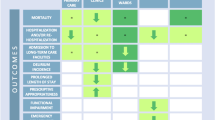Abstract
This research note describes and discusses a study which investigated the feasibility of using an individualised approach to measure the quality of life (QoL) of a sample of older people who were in receipt of an early hospital discharge service. Most participants (86%) were able to identify areas of their lives which were important to them, rate their level of functioning on each of these areas and rank their life areas in order of importance. However, 39% were unable to quantify the relative importance of each area of life. Indeed, the majority (57%) of participants who were over 75 years old could not complete this ‘weighting’ or evaluative stage. The results suggest that the phenomenological approach to measuring QoL may be employed successfully with older people but that the ‘weighting’ system used by existing individualised QoL measures needs to be refined, especially when assessing people over 75.
Similar content being viewed by others
References
Katz S, Ford AB, Moskowitz RW. The index of ADL: A standardised measure of biological and psychosocial func-tion. JAMA 1963; 185: 914–919.
Mahoney FI, Barthel DW. Functional evaluation: The Barthel Index. Maryland State Med J 1965; 14: 61–65.
Duke University Center for the Study of Aging and Human Development. Multidimensional Functional Assessment: The OARS Methodology. Durham: NC, 1978.
Pfeiffer E, Johnson TM, Chiofolo RC. Functional assess-ment of elderly subjects in four service settings. J Am Geriatr Soc 1981; 29: 433–437.
Allison PJ, Locker D, Feine JS. Quality of life: A dynamic construct. Soc Sci Med 1997; 45: 221–230.
Pearlman RA, Uhlmann RF. Quality of life in chronic diseases: Perceptions of elderly patients. J Gerontol 1988; 43: M25–M30.
O'Boyle CA. Measuring the quality of later life. Philos Trans Roy Soc Lon – Biol Sci 1997; 352: 1871–1879.
O'Boyle CA, Browne J, Hickey A, McGee HM, Joyce CRB. Schedule for the Evaluation of Individual Quality of Life (SEIQoL) Administration Manual. Dublin: Depart-ment of Psychology, Royal College of Surgeons in Ireland, 1995.
Ruta DA, Garratt AM, Leng M, Russell IT, MacDonald LM. A new approach to the measurement of quality of life: The Patient Generated Index. Med Care 1994; 32: 1109–1126.
Amir M, Bar-On D, Penso R. Positive–Negative Evalua-tion (PNE) scale: A new dimension of the subjective do-mains of quality of life measure. Qual Life Res 1996; 5: 73–80.
Hickey AM, Bury G, O'Boyle CA, Bradley F, O'Kelly FD, Shannon W. A new short form individual quality of life measure (SEIQoL-DW): Application in a cohort of individuals with HIV/AIDS. Br Med J 1996; 313: 29–33.
O'Boyle CA, McGee H, Hickey A, O'Malley K, Joyce CRB. Individual quality of life in patients undergoing hip replacement. Lancet 1992; 339: 1088–1091.
McGee HM, O'Boyle CA, Hickey A, O'Malley K, Joyce CRB. Assessing the quality of life of the individual: The SEIQoL with a healthy and a gastroenterology unit popu-lation. Psychol Med 1991; 21: 749–759.
Jenkinson C, Stradling J, Petersen S. How should we evaluate health status? A comparison of three methods in patients presenting with obstructive sleep apnoea. Qual Life Res 1998; 7: 95–100.
Herd RM, Tidman MJ, Ruta DA, Hunter JA. Measure-ment of quality of life in atopic dermatitis: Correlation and validation of two different methods. Br J Dermatol 1997; 136: 502–507.
Bar-On D, Amir M. Re-examining quality of life of hy-pertensives: A new self-structured measure. Am J Hyper-tension 1993; 6: 62S–66S.
Browne JP, O'Boyle CA, McGee HM, et al. Individual quality of life in the healthy elderly. Qual Life Res 1994; 3: 235–244.
Coen R, O'Mahony D, O'Boyle C, Joyce CRB, Hiltbrunner B, Walsh JB. Measuring the quality of life of dementia patients using the Schedule for the Evaluation of Individual Quality of Life. Irish J Psychol 1993; 14: 154–163.
Browne JP, O'Boyle CA, McGee HM, McDonald NJ, Joyce CR. Development of a direct weighting procedure for quality of life domains. Qual Life Res 1997; 6: 301–309.
Korten AE, Henderson AS, Christensen H, et al. A pro-spective study of cognitive function in the elderly. Psychol Med 1997; 27: 919–930.
Mangione CM, Seddon JM, Cook EF, et al. Correlates of cognitive function scores in elderly outpatients. J Am Geriatr Soc 1993; 41: 491–497.
Author information
Authors and Affiliations
Rights and permissions
About this article
Cite this article
Dempster, M., Donnelly, M. How well do elderly people complete individualised quality of life measures: An exploratory study. Qual Life Res 9, 369–375 (2000). https://doi.org/10.1023/A:1008959925664
Issue Date:
DOI: https://doi.org/10.1023/A:1008959925664




